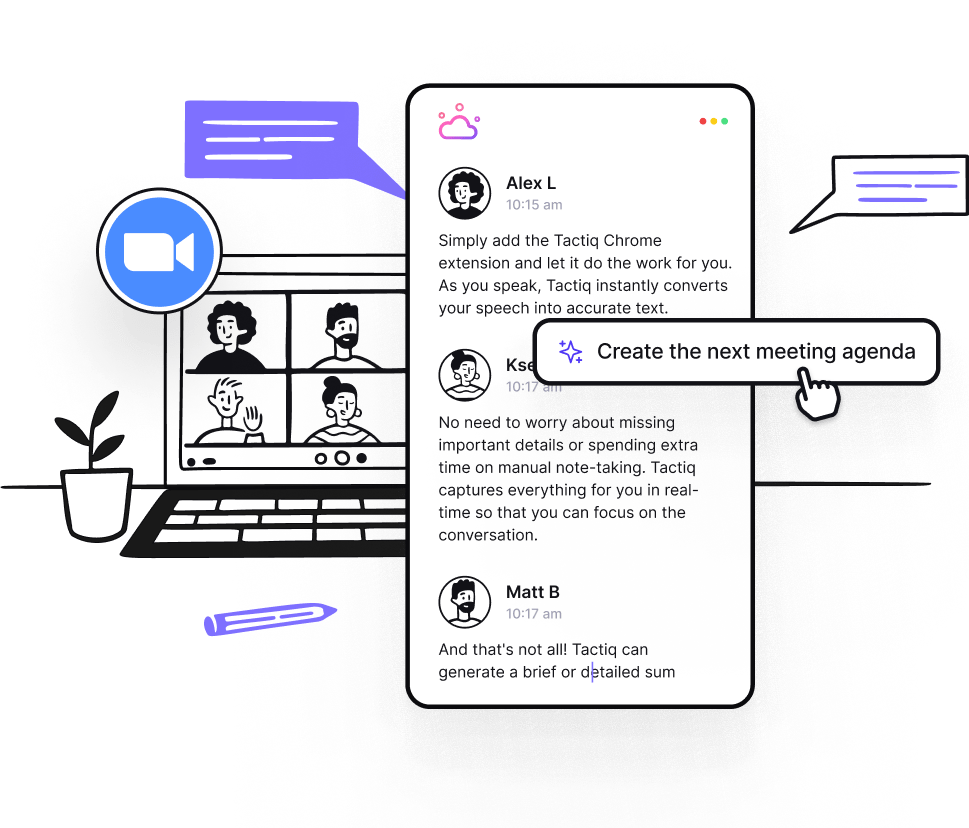How to Make Someone a Co-Host on Zoom
August 20, 2024
August 20, 2024
June 12, 2025
June 12, 2025
It’s challenging to navigate Zoom meetings when managing a large number of participants. Assigning a co-host can significantly ease the process and lead to a more organized and efficient meeting.
In this article, you’ll learn how to make someone a co-host on Zoom, what responsibilities they have, and how their role differs from the host's.
For more detailed tips and resources, check out our complete Zoom guide.
What is a Co-Host or Alternative Host on Zoom?

The co-host feature allows designated participants to share some of the host’s responsibilities during a meeting. While the host starts the meeting, co-hosts help manage it. They can mute participants, manage breakout rooms and the waiting room, and more. This role makes it easier to run large or complex meetings smoothly.
Differences Between Host and Co-Host Roles
- Host - The person who schedules and starts the meeting. Only one host per meeting.
- Co-Host - Assigned during the meeting by the host. You can assign any number of co-hosts depending on your needs.
Key Differences:
- Meeting Control - Host-only permissions include actions such as live streaming, end meeting controls, and assigning alternative hosts.
- Assignment - The host can assign and remove co-hosts. Co-hosts cannot assign other co-hosts.
- Starting the Meeting - It's important to note that the co-host start function is not available for them, so they cannot initiate the meeting. Only the host can initiate the meeting.
Why Assign a Co-Host on Zoom
Assigning a co-host on Zoom is essential for managing larger or more complex meetings. Here’s why having a co-host can make a significant difference:
Improved Meeting Management
A co-host can help control various aspects of the meeting and manage participants, making everything run more smoothly:
- Muting Participants - Co-hosts can mute or unmute participants, ensuring that background noise doesn't disrupt the meeting.
- Managing Breakout Rooms - They can organize and oversee breakout rooms, which is crucial for workshops or group activities.
- Screen Sharing Control - Co-hosts can control who shares their screen, preventing unwanted interruptions.
Enhanced Participant Engagement
Engaging participants becomes easier with a co-host:
- Monitoring Chat and Q&A - A co-host can keep an eye on the chat and Q&A sections and ensure all questions and comments are addressed.
- Launching Polls - They can also start and manage polls to gather instant feedback from participants.
- Spotlighting Speakers - Co-hosts can spotlight different speakers, so everyone gets the attention they need.
Shared Responsibilities for Smoother Meetings
Sharing the workload ensures a more organized and effective meeting:
- Focus on Content - The host can concentrate on delivering content while the co-host helps manage the administrative side and technical aspects of the meeting.
- Task Delegation - You can assign a co-host to manage specific tasks like monitoring chat, handling breakout rooms, or sharing polls.
- Real-Time Problem Solving - If any issues arise, the co-host can address them immediately without interrupting the flow of the meeting.
Backup for Technical Issues and Interruptions
Technical issues can happen at any time, and having a co-host provides a safety net:
- Maintaining Continuity - If the host's internet connection fails, the co-host can take over and keep the meeting going.
- Troubleshooting - Co-hosts can help troubleshoot technical problems that participants might face, such as audio or connectivity issues.
- Emergency Management - In case the host needs to leave unexpectedly, the co-host ensures that the meeting continues smoothly.
Assigning a co-host in Zoom meetings enhances control, engagement, and reliability. This makes the overall experience better for everyone involved.
How to Enable the Co-Host Feature in Zoom Settings
Enabling the co-host feature in Zoom is straightforward but requires a few key steps. Here's how you can do it:
- Open your browser and go to zoom.us. Sign in to your account.
- On the left-hand side menu, click “Account Management” then “Account Settings.”
- Under the "Meeting" tab, scroll down to the "In Meeting (Basic)" section.
- Find the "Co-host" setting and toggle it on.

- Ensure you save any changes you make.
Requirements for adding an alternative host on Zoom
- Account Type - Only certain Zoom accounts have the alternative host feature. Here’s what you need:
- Pro, Business, Education, or API Partner Plan - Basic (free) accounts do not have access to the alternative host feature.
- Admin Privileges - Ensure you have the necessary permissions to edit account settings.
Common Issues and Troubleshooting Tips
Even with the steps above, you might encounter some issues. Here’s how to solve them:
- Permissions Problems - Double-check if you have admin rights. Only admins can enable this feature.
- Update Zoom - Sometimes, updating your Zoom client can solve unexpected issues.
- Browser Cache - Clear your browser cache if settings do not appear to save correctly.
By following these steps and checking the requirements, you ensure the feature is enabled and ready for use in your next meeting.
How to Make Someone a Co-Host During a Zoom Meeting
Assigning a co-host during a live Zoom call is simple. Follow these steps to ensure a smooth process.
- Start your Zoom meeting.
- Click "Participants" located on the meeting controls at the bottom of your Zoom window.
- In the participants panel, hover over the name of the person you prefer.
- Click the “More” button that appears next to their name.
- From the dropdown menu, select “Make Co-Host.”

Image from Zoom
- A pop-up will ask you to confirm that you want to make this participant a co-host. Click “Yes.”
How to Add Someone as a Co-Host on Zoom (Mobile)
If you're running a meeting from your phone or tablet, you can still assign a co-host using the Zoom mobile app. Here's how to do it on both iOS and Android:
- Open the Zoom app on your mobile device and start the scheduled meeting as the host.
- At the bottom of the screen, tap the “Participants” button to see a list of attendees.
- Find the person you want to make a co-host. Tap their name to open additional options.
- From the pop-up menu, tap “Make Co-Host.” You’ll be prompted to confirm—tap “Yes” to finalize.
Tips for Effective Zoom Co-Hosts Assignment
Assigning a co-host to share hosting privileges can enhance your meeting experience:
- Select participants who understand Zoom and are responsible.
- Explain their roles clearly before or during the meeting.
- Ensure your co-hosts are managing their tasks well.
What to Do If There Is No Co-Host Option in Zoom
If you can't find the co-host option during your meeting:
- Confirm you have a Pro, Business, Education, or API Partner Plan.
- Ensure your Zoom client is up to date.
- Go back to your Zoom settings and make sure the feature is enabled.
- Restart the Meeting: Sometimes, simply ending the meeting and restarting it can fix the issue.
By following these steps and tips, you can efficiently assign co-hosts during your Zoom meetings, ensuring a smoother and more organized session.
How to Make Someone a Co-Host Before a Zoom Meeting
Setting up a co-host before your scheduled Zoom meetings can save you time. Here’s how to do it:
Using Zoom Scheduling Tools
After you’ve enabled this feature in your settings, check out Zoom’s other tools to help you schedule meetings and assign co-hosts:

- Navigate to the “Meetings” tab and click “Schedule a Meeting.”
- Enter the necessary information, such as topic, description, date, and time.
- Scroll down to the “Options” section and find the “Alternative Hosts” field. Enter the email addresses of the people you want to make co-hosts. If adding multiple, separate each email with a comma.
Sending Co-Host Invitations
Once you've scheduled the meeting and assigned co-hosts:
- Click “Save” and then use the provided options to send invitations—these can be sent via email, calendar invites, or through a copy of the meeting link.
- Communicate with your alternative hosts to let them know they have been assigned this role. This helps them prepare in advance.
By setting up co-hosts in advance, using Zoom’s scheduling tools effectively, sending clear invitations, and ensuring all settings are correct, you can ensure your meeting runs seamlessly from start to finish.
{{rt_cta_ai-convenience}}
How Can Tactiq Support Co-Hosts in Zoom Meetings?

Assigning a co-host helps divide responsibilities during a Zoom call, but keeping track of everything still takes effort. This is where Tactiq can make a difference. It’s a smart tool that improves your Zoom AI experience with live transcription, AI-powered notes, and automated follow-ups—making it easier for both hosts and co-hosts to stay aligned and focused.
Here’s how Tactiq can support your meeting management:
- Live Transcriptions and AI Summaries
Tactiq provides real-time Zoom transcription so every instruction, decision, and co-host responsibility is captured accurately. Co-hosts can refer back to summaries to clarify their roles or follow up on tasks without interrupting the meeting.
Tactiq automatically generates detailed meeting notes so co-hosts don’t have to write things down while multitasking. This reduces the chance of missing key points or action items.
- AI Meeting Kits and Custom Prompts
Use pre-built or personalized AI meeting kits to assign action items, create summaries, or generate follow-up emails. Co-hosts can use these kits to quickly handle their tasks after the meeting.
- Searchable Transcripts
Need to review a decision or instruction from earlier in the call? Co-hosts can easily search the transcript by keyword, making it faster to find and reference critical details.
- Export Transcripts from Zoom Recordings
With Tactiq, you can easily export transcripts from Zoom recordings to use in meeting notes and project docs, or to share with absent teammates.
Tactiq now supports AI workflows that automatically extract insights from meetings and update tools like Notion, HubSpot, and Linear. Co-hosts can set up workflows that notify teams, update records, or create tickets right after the call—no manual input needed.
Tactiq gives hosts and co-hosts the tools to collaborate better before, during, and after every meeting. Download the free Tactiq Chrome Extension today!
Make the Most of Your Zoom Meetings
Giving someone co-host privileges is more than just a backup plan—it’s a smart way to delegate tasks, improve engagement, and keep things running smoothly.
Co-hosts can help handle everything, from breakout rooms to chat moderation. Pair this with a tool like Tactiq, and you can automate note-taking, export transcripts from Zoom recordings, and stay focused on the conversation.
The result?
Meetings that are more productive, more organized, and easier to manage.
To add a co-host, start your Zoom meeting, open the Participants panel, hover over a participant’s name, click “More,” and select “Make Co-Host.” Make sure the co-host feature is enabled in your Zoom settings.
Zoom does not support permanent co-hosts. However, you can assign someone as an alternative host when scheduling the meeting. This lets them start the meeting and become the host if you're not present.
An alternative host is assigned before the meeting and can start it if the host is unavailable. A co-host is assigned during the meeting and can help manage it but cannot start or end it.
No, you can only assign the co-host role during a live meeting. If you want someone to have host privileges from the start, assign them as an alternative host when scheduling the meeting.
The host controls the entire meeting, including starting, ending, and managing roles. Co-hosts assist with moderation tasks like managing participants and breakout rooms but cannot start or end the meeting.
Want the convenience of AI summaries?
Try Tactiq for your upcoming meeting.
Want the convenience of AI summaries?
Try Tactiq for your upcoming meeting.
Want the convenience of AI summaries?
Try Tactiq for your upcoming meeting.









